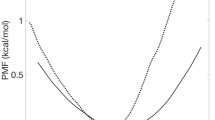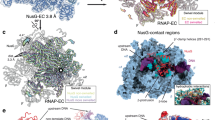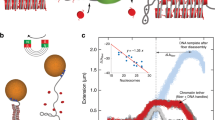Abstract
The torsional stress caused by counter-rotation of the transcription machinery and template generates supercoils in a closed topological domain, but has been presumed to be too short-lived to be significant in an open domain. This report shows that transcribing RNA polymerases dynamically sustain sufficient torsion to perturb DNA structure even on linear templates. Assays to capture and measure transcriptionally generated torque and to trap short-lived perturbations in DNA structure and conformation showed that the transient forces upstream of active promoters are large enough to drive the supercoil-sensitive far upstream element (FUSE) of the human c-myc into single-stranded DNA. An alternative non-B conformation of FUSE found in stably supercoiled DNA is not accessible dynamically. These results demonstrate that dynamic disturbance of DNA structure provides a real-time measure of ongoing genetic activity.
This is a preview of subscription content, access via your institution
Access options
Subscribe to this journal
Receive 12 print issues and online access
$189.00 per year
only $15.75 per issue
Buy this article
- Purchase on Springer Link
- Instant access to full article PDF
Prices may be subject to local taxes which are calculated during checkout








Similar content being viewed by others
References
Liu, L.F. & Wang, J.C. Supercoiling of the DNA-template during transcription. Proc. Natl. Acad. Sci. USA 84, 7024–7027 (1987).
Harada, Y. et al. Direct observation of DNA rotation during transcription by Escherichia coli RNA polymerase. Nature 409, 113–115 (2001).
Sinden, R.R. DNA Structure and Function (Academic Press, San Diego, 1994).
Bates, A.D. & Maxwell, A. DNA Topology (IRL Press at Oxford Univ. Press, New York, 1993).
Collins, I., Weber, A. & Levens, D. Transcriptional consequences of topoisomerase inhibition. Mol. Cell. Biol. 21, 8437–8451 (2001).
Tomonaga, T. et al. Unrestraining genetic processes with a protein-DNA hinge. Mol. Cell 1, 759–764 (1998).
Havas, K. et al. Generation of superhelical torsion by ATP-dependent chromatin remodeling activities. Cell 103, 1133–1142 (2000).
Cozzarelli, N.R. & Wang, J.C. DNA Topology and Its Biological Effects (Cold Spring Harbor Laboratory Press, Cold Spring Harbor, New York, 1990).
Nelson, P. Transport of torsional stress in DNA. Proc. Natl. Acad. Sci. USA 96, 14342–14347 (1999).
Marko, J.F. DNA under high tension: overstretching, undertwisting, and relaxation dynamics. Phys. Rev. E 57, 2134–2149 (1998).
Droge, P. Transcription-driven site-specific DNA recombination in vitro. Proc. Natl. Acad. Sci. USA 90, 2759–2763 (1993).
Wang, Z.Y. & Droge, P. Long-range effects in a supercoiled DNA domain generated by transcription in vitro. J. Mol. Biol. 271, 499–510 (1997).
Ostrander, E.A., Benedetti, P. & Wang, J.C. Template supercoiling by a chimera of yeast Gal4 protein and phage-T7 RNA-polymerase. Science 249, 1261–1265 (1990).
He, L. et al. Loss of FBP function arrests cellular proliferation and extinguishes c-myc expression. EMBO J. 19, 1034–1044 (2000).
Duncan, R. et al. Sequence-specific, single-strand binding-protein activates the far upstream element of c-myc and defines a new DNA-binding motif. Genes Dev. 8, 465–480 (1994).
Michelotti, G.A. et al. Multiple single-stranded cis elements are associated with activated chromatin of the human c-myc gene in vivo . Mol. Cell. Biol. 16, 2656–2669 (1996).
Liu, J., et al. Defective interplay of activators and repressors with TFIIH in xeroderma pigmentosum. Cell 104, 353–363 (2001).
Sassedwight, S. & Gralla, J.D. KMnO4 as a probe for lac promoter DNA melting and mechanism in vivo . J. Biol. Chem. 264, 8074–8081 (1989).
Blaszak, R.T., Potaman, V., Sinden, R.R. & Bissler, J.J. DNA structural transitions within the PKD1 gene. Nucleic Acids Res. 27, 2610–2617 (1999).
Potaman, V.N. et al. Length-dependent structure formation in Friedreich ataxia (GAA)n*(TTC)n repeats at neutral pH. Nucleic Acids Res. 32, 1224–1231 (2004).
Dai, X., Greizerstein, M.B., Nadas-Chinni, K. & Rothman-Denes, L.B. Supercoil-induced extrusion of a regulatory DNA hairpin. Proc. Natl. Acad. Sci. USA 94, 2174–2179 (1997).
Dai, X., Kloster, M. & Rothman-Denes, L.B. Sequence-dependent extrusion of a small DNA hairpin at the N4 virion RNA polymerase promoters. J. Mol. Biol. 283, 43–58. (1998).
Peck, L.J. & Wang, J.C. Energetics of B-to-Z transition in DNA. Proc. Natl. Acad. Sci. USA 80, 6206–6210 (1983).
Kowalski, D., Natale, D.A. & Eddy, M.J. Stable DNA unwinding, not breathing, accounts for single-strand-specific nuclease hypersensitivity of specific A+T-rich sequences. Proc. Natl. Acad. Sci. USA 85, 9464–9468 (1988).
Potaman, V.N. et al. Unpaired structures in SCA10 (ATTCT)(n).(AGAAT)(n) repeats. J. Mol. Biol. 326, 1095–1111 (2003).
Kang, S., Wohlrab, F. & Wells, R.D. GC-rich flanking tracts decrease the kinetics of intramolecular DNA triplex formation. J. Biol. Chem. 267, 19435–19442 (1992).
Hanvey, J.C., Shimizu, M. & Wells, R.D. Intramolecular DNA triplexes in supercoiled plasmids. II. Effect of base composition and noncentral interruptions on formation and stability. J. Biol. Chem. 264, 5950–5956 (1989).
Abremski, K., Hoess, R. & Sternberg, N. Studies on the properties of P1 site-specific recombination—evidence for topologically unlinked products following recombination. Cell 32, 1301–1311 (1983).
Abremski, K., Frommer, B. & Hoess, R.H. linking-number changes in the DNA substrate during Cre-mediated loxP site-specific recombination. J. Mol. Biol. 192, 17–26 (1986).
Adachi, N. & Lieber, M.R. Bidirectional gene organization: a common architectural feature of the human genome. Cell 109, 807–809 (2002).
Takai, D. & Jones, P.A. Origins of bidirectional promoters: computational analyses of intergenic distance in the human genome. Mol. Biol. Evol. 21, 463–467 (2004).
Liu, J. et al. The FBP interacting repressor targets TFIIH to inhibit activated transcription. Mol. Cell 5, 331–341 (2000).
van Holde, K. & Zlatanova, J. Unusual DNA structures, chromatin and transcription. Bioessays 16, 59–68 (1994).
Krasilnikov, A.S., Podtelezhnikov, A., Vologodskii, A. & Mirkin, S.M. Large-scale effects of transcriptional DNA supercoiling in vivo . J. Mol. Biol. 292, 1149–1160 (1999).
Leng, F. & McMacken, R. Potent stimulation of transcription-coupled DNA supercoiling by sequence-specific DNA-binding proteins. Proc. Natl. Acad. Sci. USA 99, 9139–9144 (2002).
Bennink, M.L. et al. Unfolding individual nucleosomes by stretching single chromatin fibers with optical tweezers. Nat. Struct. Biol. 8, 606–610 (2001).
Brower-Toland, B.D. et al. Mechanical disruption of individual nucleosomes reveals a reversible multistage release of DNA. Proc. Natl. Acad. Sci. USA 99, 1960–1965 (2002).
Epshtein, V., Toulme, F., Rahmouni, A.R., Borukhov, S. & Nudler, E. Transcription through the roadblocks: the role of RNA polymerase cooperation. EMBO J. 22, 4719–4727 (2003).
Rhee, K.Y. et al. Transcriptional coupling between the divergent promoters of a prototypic LysR-type regulatory system, the ilvYC operon of Escherichia coli . Proc. Natl. Acad. Sci. USA 96, 14294–14299 (1999).
Cawley, S. et al. Unbiased mapping of transcription factor binding sites along human chromosomes 21 and 22 points to widespread regulation of noncoding RNAs. Cell 116, 499–509 (2004).
Ohba, R., Matsumoto, K. & Ishimi, Y. Induction of DNA replication by transcription in the region upstream of the human c-myc gene in a model replication system. Mol. Cell. Biol. 16, 5754–5763 (1996).
Benham, C.J. Sites of predicted stress-induced DNA duplex destabilization occur preferentially at regulatory loci. Proc. Natl. Acad. Sci. USA 90, 2999–3003 (1993).
Sheflin, L.G. & Kowalski, D. Altered DNA conformations detected by mung bean nuclease occur in promoter and terminator regions of supercoiled PBR322 DNA. Nucleic Acids Res. 13, 6137–6154 (1985).
Singleton, C.K. & Wells, R.D. The facile generation of covalently closed, circular DNAs with defined negative superhelical densities. Anal. Biochem. 122, 253–257 (1982).
Keller, W. Determination of the number of superhelical turns in simian virus 40 DNA by gel electrophoresis. Proc. Natl. Acad. Sci. USA 72, 4876–4880 (1975).
Rhodes, D. & Klug, A. Helical periodicity of DNA determined by enzyme digestion. Nature 286, 573–578 (1980).
Acknowledgements
We thank L. Liotta, D. Clark, D. Boles and L. Benjamin for critical comments.
Author information
Authors and Affiliations
Corresponding author
Ethics declarations
Competing interests
The authors declare no competing financial interests.
Supplementary information
Supplementary Fig. 1
Effect of transcription on KMnO4 reactivity at the FUSE element. (PDF 46 kb)
Supplementary Fig. 2
Influence of the viscosity of the reaction media, and nascent transcript length on the intensity of dynamic supercoiling. (PDF 43 kb)
Supplementary Fig. 3
Evanescent nature of the transcriptionally generated stress. (PDF 48 kb)
Rights and permissions
About this article
Cite this article
Kouzine, F., Liu, J., Sanford, S. et al. The dynamic response of upstream DNA to transcription-generated torsional stress. Nat Struct Mol Biol 11, 1092–1100 (2004). https://doi.org/10.1038/nsmb848
Received:
Accepted:
Published:
Issue Date:
DOI: https://doi.org/10.1038/nsmb848
This article is cited by
-
Ligands stimulating antitumour immunity as the next G-quadruplex challenge
Molecular Cancer (2022)
-
Reciprocal regulation of cellular mechanics and metabolism
Nature Metabolism (2021)
-
Supercoiling and looping promote DNA base accessibility and coordination among distant sites
Nature Communications (2021)
-
The regulation and functions of DNA and RNA G-quadruplexes
Nature Reviews Molecular Cell Biology (2020)
-
Theoretical Model of Transcription Based on Torsional Mechanics of DNA Template
Journal of Statistical Physics (2019)



